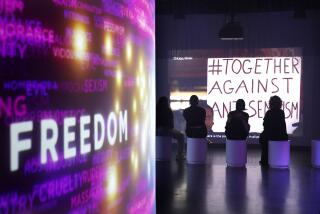Covering Hate Vandals: Itâs Not a Black-and-White Case
You get newspaper space three times a week to express an opinion if you want to, but what do you do when youâre not sure what your opinion is?
The latest conundrum involves the spate of anti-black or anti-ethnic group scrawlings and graffiti that have shown up around Orange County.
By now, you know the routine. The hate vandals scribble a bigoted message--in the most recent cases, on walls at a Mission Viejo high school, a Lake Forest nursery school and at UC Irvine--and then wait for the reaction.
That reaction also has become predictable. Rusty Kennedy of the county Human Relations Commission deplores the incidents, the Sheriffâs Department begins a hate-crime investigation and various organizations condemn the action. The Times gives prominent display to the incidents.
The whole thing has become almost like a long-running play on Broadway; people know their parts and act accordingly.
So I find myself asking: Does it make any difference?
I find myself toying with the notion that maybe we shouldnât give the hate vandals any attention. Or maybe not as much. What if itâs just three punks with some spray paint who have a temporary Nazi hang-up? Maybe they think the swastika is a cool insignia but donât really know what it represents. Maybe they think the Ku Klux Klan has a catchy alliteration to it but theyâll grow out of their racist sloganeering. Maybe by giving them such prominence weâre feeding the egos of a few anonymous misfits and not really chronicling a significantly dangerous local trend.
Thus, the conundrum: If we ignore them or publicize them less prominently, will they go away? Or do we have a moral obligation, all of us, to aggressively attack any semblance of racism or bigotry whenever it rears its ugly heads, no matter how rote the response begins to sound?
I handed off the baton to four friends, two blacks and two Jews. How should we handle stories like that, I asked them. They eased my conscience somewhat by offering slightly differing opinions--that is, their lack of unanimity validated my own wavering.
None of the four said the incidents should be ignored. But three of the four said the sameness of the incidents might not warrant continuing front-page treatment.
I asked a Jewish friend if we should keep responding. âIt depends on who âweâ are,â he said. âThe Anti-Defamation League, the Bânai Bârith and the NAACP do have to. Whether you or Columnist X, Y or Z has to, I donât think so. If someone is hurt or killed or if someone makes a movie or record about (a hate message), maybe it should be responded to, but not every isolated incident has to be responded to.â
Another Jewish friend disagreed. âIgnore it and all of a sudden, youâve got Nazi Germany again,â he said, adding that âsome of the darkest moments in our historyâ occurred when people didnât address wrongdoing.
He acknowledged my lament about the near-scripted nature of the crime-and-response cycle but said the subject has to be confronted, even if not necessarily as front-page news.
âIf you ignore it and say âitâs not my problem,â it is your problem,â he said. âYou canât ever turn a cheek to hate. You donât know the motive of the people who did it, but even if it was three kids who did it (as a lark), maybe thatâs even more disturbing.â
He said anti-Semitism still lurks. He said his wife, who isnât Jewish, was recently collecting donations for a school benefit when one of the other parents said: âThose Jews over at such-and-such are so cheap.â
Giving hate-incident stories either minimal or no coverage would seem like condoning them or deeming them unimportant, a black friend said. The next thing you know, he said, youâve got people in three-piece suits and with a little cosmetic surgery making themselves look more presentable but giving the same hate message (a la former KKK leader David Duke).
His theory is that ignoring any manifestation of a hate crime is âlike ignoring a lump on your breast.â
Another black friend is somewhat less insistent about displaying such stories so prominently. âIt has to be covered, but I donât think it has to be splattered on the front page,â especially, she said, if it was the latest in an ongoing series of similar events.
âIf it were the 10th time, Iâd still cover it, but maybe not the front page. But it has to be covered. If it happens so many times, you canât keep running it on the front page. Itâs like regular news. It gets old. That doesnât mean itâs right, but it can give a charge to the people to continue to do it.â
I asked if sheâs still upset reading about incidents like that or if she dismisses them as the work of isolated vandals.
âIâm still upset because theyâre increasing,â she said. âItâs not like theyâre going away. Things are not getting better.â


